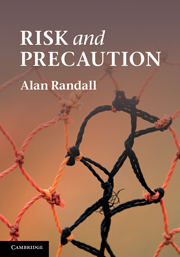Book contents
- Frontmatter
- Contents
- List of figures
- List of boxes
- Authors cited
- Acknowledgements
- List of acronyms
- Part I The precautionary principle – why so much fuss about such a simple idea?
- Part II Harm and chance – managing risk
- Part III Defining and justifying a coherent precautionary principle
- 6 A defensible precautionary principle must withstand these challenges
- 7 Toward a precautionary principle framework: evidence, threat, and remedy
- 8 Threat and evidence
- 9 Remedy
- 10 Precaution for utilitarians?
- 11 A robust and defensible precautionary principle
- Part IV Precaution in action
- Part V Conclusion
- References
- Index
11 - A robust and defensible precautionary principle
Published online by Cambridge University Press: 05 June 2012
- Frontmatter
- Contents
- List of figures
- List of boxes
- Authors cited
- Acknowledgements
- List of acronyms
- Part I The precautionary principle – why so much fuss about such a simple idea?
- Part II Harm and chance – managing risk
- Part III Defining and justifying a coherent precautionary principle
- 6 A defensible precautionary principle must withstand these challenges
- 7 Toward a precautionary principle framework: evidence, threat, and remedy
- 8 Threat and evidence
- 9 Remedy
- 10 Precaution for utilitarians?
- 11 A robust and defensible precautionary principle
- Part IV Precaution in action
- Part V Conclusion
- References
- Index
Summary
In this chapter, the objectives are to specify a robust precautionary principle drawing on the findings of Chapters 7 – 10, and to show that it is defensible, which I interpret as meaning that it withstands the challenges considered in Chapter 6 and summarized in Box 6.3.
The structure of a robust precautionary principle
It makes sense to apply PP to novel situations that generate a chance of extraordinary harm. Novel situations highlight the knowledge issue, and the PP is all about invoking appropriate remedies for uncertain harm. We have distinguished three kinds of novel situations that may involve a chance of harm (Chapter 9):
Novel interventions ex ante, NI1 – proposed novel interventions.
Novel interventions ex post, NI2 – novel interventions already implemented and in many cases widely dispersed and integrated into the matrix of business-as-usual.
Novel outcomes from overstressing systems in the course of business-as-usual, BAU – customary patterns of exploitation, pollution, etc., fully integrated into the matrix of business-as-usual, may threaten harmful regime shifts.
These situations have quite different implications for the knowledge issues that arise. For example, we may be able to pre-screen NI1 cases for harmful possibilities, but with NI2 and BAU cases the focus shifts from pre-screening to early warning indicators of harmful effects in the real world. They also have implications for the menu of feasible remedies.
- Type
- Chapter
- Information
- Risk and Precaution , pp. 184 - 192Publisher: Cambridge University PressPrint publication year: 2011



